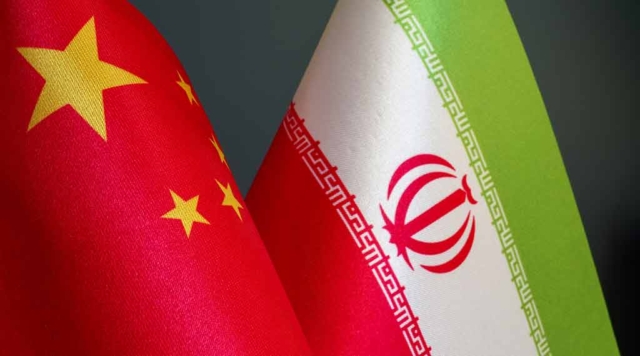Iran works as China’s proxy to push U.S. out of the Middle East
By Center For Security Policy

The dots of sub-regional conflicts in the Middle East are now connecting as a concerted and coordinated campaign to drive the United States and Israel out of the Middle East.
From a geostrategic perspective, the panorama of these flashpoints is starting to make sense. From the shameful debacle of America’s chaotic retreat from Afghanistan, the message was clear to China and its proxies: the United States was an untrusted ally with little resolve. From then on, Iran felt unconstrained to plan a broader campaign against the United States.
It started on Oct. 7, 2023, with the deadly Hamas sally forth from multiple pre-planned breach points into Israel. American base camps in Iraq and Syria—shut down by former President Donald Trump after defeating ISIS, Abu Bakr al-Baghdadi, and Qassem Soleimani—have been reopened by the Biden administration and are now under regular attack with multiple American service members and contractors being wounded. Seeing everything in play, this appears to be a coordinated action with the possible end state of a Middle East without an American presence.
Raging Naval War in Red Sea, Gulf of Aden
Starting on Nov. 19, 2023, with the seizure of the Galaxy Leader, an empty car carrier transiting the Red Sea, a second sub-regional conflict broke out. This has rapidly expanded into a broader war against merchant shipping in additional areas, including the Gulf of Aden, the Arabian Sea, and even the broader Indian Ocean, with the CMA CGM Symi being struck close to India with a cruise missile fired from Iranian territory.
This is the broadest and most aggressive onslaught against merchant vessel traffic since the Battle of the North Atlantic in World War II. Xiao Yunhua, a professor at the People’s Liberation Army National Defense University, implicated the Chinese Communist Party’s (CCP) strategy by saying the quiet part out loud and complimenting the Houthis of Yemen for blocking Western supply chains.
The American-orchestrated Operation Prosperity Garden started out a bit roughly, with several nations not wanting to participate, protecting only their own merchant vessels, or not wanting to be publicly acknowledged. The attacks continued from November and included multiple shootdowns of drones, cruise missiles, and “ballistic” missiles, targeting merchant vessels, Western warships, and some heading toward Israel. On Jan. 11, the first airstrikes on Yemeni territory commenced.
The Houthis seemed unfazed and continued to launch and fire ordnance to hit merchant traffic despite a growing number of airstrikes. The U.S. Central Command’s Twitter account is becoming the focal point for attempting to track the daily shoot-outs. The American, British, French, Indian, Dutch, Australian, and other navies have performed heroically and remarkably well. Still, they are expending high-end ordnance and missiles at a quickening pace, which in many ways benefits the Iranian and Chinese agendas.
A faster and more cost-effective counter-air capability is needed. Long-discussed laser self-defense capabilities are not yet mature enough and deployed pervasively. Key warships, like the USS Gravely, still show that long empty forward position for a close-in weapons system. The U.S. Navy finds its warships in a situation similar to the early days of World War II, where pre-war anti-aircraft armament failed to keep up with the Japanese air frenzy. Shortly, American Navy ships bristled with 20 mm, 40 mm, 5-inch cannons, and many other forms of armament.
Iran Targets US Base Camps With Ballistic Missiles
Broadening the conflict, Israel is regularly striking into Lebanon at Hezbollah targets and has meted out decisive punishment to Iranian senior advisers in Syria, including a high-ranking Iranian general. Shortly after that, in Iran, during an event marking the fourth anniversary of the death of Soleimani, the head of the Revolutionary Guard’s elite Quds Force killed by American forces in 2020, two bombs detonated, resulting in over 100 casualties. It’s unclear who set the bombs at the gathering, but these events brought the expanding conflict directly to Iranian leadership and the Iranian homeland.
Iran has now fired ballistic missiles from Iranian territory at U.S. base camps in Erbil, Iraq, and also from inside Iraq at the major U.S. operating base in Al Asad, close to the Syrian border. Earlier in December, multiple short-range rockets were fired at the U.S. Embassy in Baghdad, with no injuries reported. Iraq is now seeking the departure of Americans and their base camps. Iran has now included nuclear-capable Pakistan as a recipient of its missiles—a very bad omen for the next phases of the growing sub-regional battlefronts in the broader Middle East.
AUTHOR
John Mills
Senior Fellow
EDITORS NOTE: This Center for Security Policy column is republished with permission. All rights reserved.

This article is courtesy of DrRichSwier.com, an online community of citizen journalists, academics, subject matter experts, and activists to express the principles of limited government and personal liberty to the public, to policy makers, and to political activists. Please visit DrRichSwier.com for more great content.

